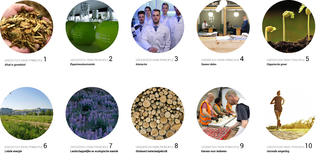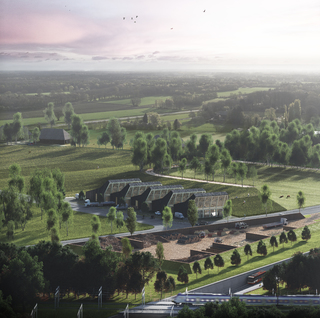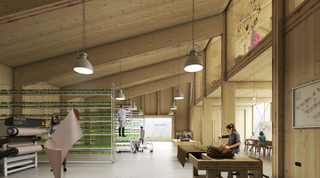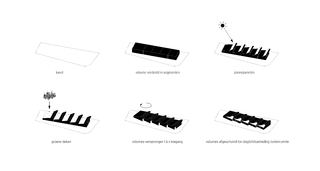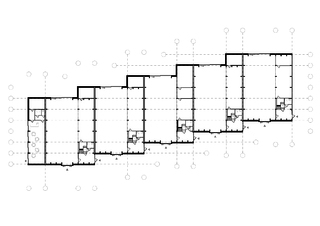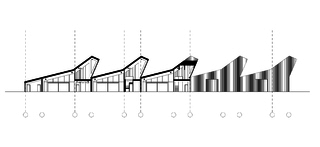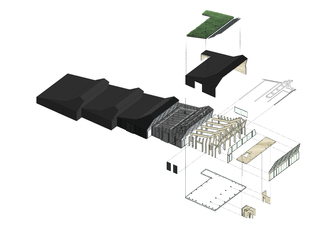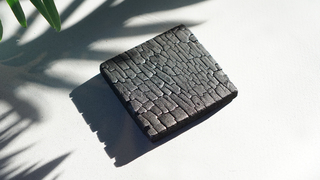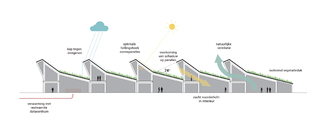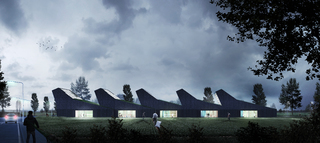
GreenTech Park
Boxtel
Collaboration on the valorisation of biomassThe Province of Noord-Brabant, the Brabant Development Company (BOM), the Northeast Brabant region (Agro Food Capital) want to boost the biobased economy with the development of GreenTech Park Brabant. GreenTech Park Brabant is an industrial area in Boxtel on which concrete projects and partnerships are realized in the field of biobased raw materials and sustainable energy.
The poplar wood GreenTech Incubator is one of the first buildings to be realized on the GreenTech Park. The building serves to accommodate start-up companies in the field of valorisation of green residual dreams, and also to house a knowledge center. The Incubator is built with organic (residual) substances and is therefore itself an example of a product that is made at GreenTech Park and the knowledge that is developed there. In addition, the Incubator has been designed so that the building makes maximum use of the climatic conditions with minimal use of energy.
In order to grow to the top of European knowledge and innovation regions, we must focus on the core idea behind the biobased economy, especially sustainable area development. Not on exploiting land and real estate, but on exploiting energy and commodities. But what does this mean? What does this emerging economy need? What are the spatial preconditions for growth? What are the spatial supports and structures of the biobased economy that support this development? What are the threats? Are spatial typologies conceivable that optimally accommodate the transition? What are the opportunities for synergy with other regional tasks? But above all, the challenge is: where do you start and how do you involve the environment?
In the GreenTech Park Brabant program, a conscious decision was made to start with the exploitation of local biomass flows. The aim is to use smart, small-scale technologies and concepts to unlock waste and residual flows at a local level and to upgrade them to valuable biobased raw materials and products, whereby not only material flows but also revenues flow back to the local community. The future will show whether a whole series of GreenTech parks will eventually emerge, or whether clustering will take place in some regional parks.
The Incubator functions and fits into the Brabant landscape just as naturally as a wooden Flemish barn
Flemish barn
One of the most characteristic elements of the Brabant landscape is the Flemish barn, a type of barn that occurs in the west and northwest of the province of Noord-Brabant and in the province of Antwerp. These barns are built of wood, with the outer walls often black-tarred. The barns generally have a thatched roof. In order to function as an efficient building within a farm, the interior space of the Flemish barns is flexible in use. The barns offer space for large-scale storage of hay and straw, for the storage of agricultural implements and, at the same time, for housing livestock, for example. In addition, Vlaamse Barns are demountable and therefore movable. With these characteristics, fitting into the landscape, flexible in use and reusable, the Vlaamse Schuur has the characteristics that the Incubator must also have. Although the Incubator must also meet modern requirements with regard to the indoor climate and usability, our aim is that the Incubator is a building that is just as functional and fits into the landscape of Brabant as naturally as a Flemish barn.
One of the most characteristic elements of the Brabant landscape is the Flemish barn, a type of barn that occurs in the west and northwest of the province of Noord-Brabant and in the province of Antwerp. These barns are built of wood, with the outer walls often black-tarred. The barns generally have a thatched roof. In order to function as an efficient building within a farm, the interior space of the Flemish barns is flexible in use. The barns offer space for large-scale storage of hay and straw, for the storage of agricultural implements and, at the same time, for housing livestock, for example. In addition, Vlaamse Barns are demountable and therefore movable. With these characteristics, fitting into the landscape, flexible in use and reusable, the Vlaamse Schuur has the characteristics that the Incubator must also have. Although the Incubator must also meet modern requirements with regard to the indoor climate and usability, our aim is that the Incubator is a building that is just as functional and fits into the landscape of Brabant as naturally as a Flemish barn.
The potential of residual flows,
especially woody biomass, is huge.
Poplar wood
The Incubator uses what the environment has to offer in many ways. This applies to the energy supply, to the use, but also to the materials with which it is built. Within a radius of 20 km a huge amount of woody biomass is present, around 7,600 tons, including a lot of poplar wood. The starting point is therefore that the CLT for the incubator is compiled from poplar wood that comes from the Boxtel area. The poplar is a cultural-historical icon and is closely linked to the former welfare plan. That is why it is important to maintain and strengthen this relationship. Poplar grows very fast compared to other types of wood such as birch, beech and oak and is therefore very suitable as a type of wood for production forests.
The Incubator uses what the environment has to offer in many ways. This applies to the energy supply, to the use, but also to the materials with which it is built. Within a radius of 20 km a huge amount of woody biomass is present, around 7,600 tons, including a lot of poplar wood. The starting point is therefore that the CLT for the incubator is compiled from poplar wood that comes from the Boxtel area. The poplar is a cultural-historical icon and is closely linked to the former welfare plan. That is why it is important to maintain and strengthen this relationship. Poplar grows very fast compared to other types of wood such as birch, beech and oak and is therefore very suitable as a type of wood for production forests.
Cross Laminated Timber
The hull of the Incubator is made of solid wood in the form of Cross Laminated Timber (CLT). It gives a tactile quality (low touch) and promotes a pleasant indoor climate. Solid timber construction also contributes to the CO2 ambitions; the production does not entail CO2 emissions, in contrast to the production of concrete and cement, which is responsible for no less than 5% of all CO2 emissions worldwide. On the contrary, with the use of a solid wood construction, a large amount of CO2 is captured for perhaps several hundred years. CLT can be fully prefabricated and assembled on site in a short time. This means that the construction time can be considerably shortened. It also offers flexibility for changing wishes in the future; wood can easily be modified.
The hull of the Incubator is made of solid wood in the form of Cross Laminated Timber (CLT). It gives a tactile quality (low touch) and promotes a pleasant indoor climate. Solid timber construction also contributes to the CO2 ambitions; the production does not entail CO2 emissions, in contrast to the production of concrete and cement, which is responsible for no less than 5% of all CO2 emissions worldwide. On the contrary, with the use of a solid wood construction, a large amount of CO2 is captured for perhaps several hundred years. CLT can be fully prefabricated and assembled on site in a short time. This means that the construction time can be considerably shortened. It also offers flexibility for changing wishes in the future; wood can easily be modified.
Segmentation
By segmenting the building mass, a scale is created that fits in better with the nearby landscape. The shape of the segments and the use of carbonised cladding refers to the Flemish barn. By chamfering the roof on the west side, characteristic roof shields are created. The bright interior shows itself to the surroundings through the large façade opening. This segmentation also improves practicability, and also makes a simple distribution possible for different users. The plan of the Incubator is flexible. As required, office spaces can be omitted or added on a mezzanine. When there is a need for more space for business activities, the mezzanine can be removed and a large open space is created. The different segments of the incubator can be joined by removing the wall between two segments.
By segmenting the building mass, a scale is created that fits in better with the nearby landscape. The shape of the segments and the use of carbonised cladding refers to the Flemish barn. By chamfering the roof on the west side, characteristic roof shields are created. The bright interior shows itself to the surroundings through the large façade opening. This segmentation also improves practicability, and also makes a simple distribution possible for different users. The plan of the Incubator is flexible. As required, office spaces can be omitted or added on a mezzanine. When there is a need for more space for business activities, the mezzanine can be removed and a large open space is created. The different segments of the incubator can be joined by removing the wall between two segments.
Material
The Incubator is made of poplar wood that shows itself on the inside in different ways. The outside is covered with dark carbonized wood. Carbonisation is a technique for making the wood more sustainable by having the outer layer burned in a controlled manner. This protects it against moisture and mold.
The Incubator is made of poplar wood that shows itself on the inside in different ways. The outside is covered with dark carbonized wood. Carbonisation is a technique for making the wood more sustainable by having the outer layer burned in a controlled manner. This protects it against moisture and mold.
Energy
The roof shape of the various segments has been optimized for the collection of sunlight with solar panels, light entry from the north and collection of rain with a vegetation roof. The glass façades are equipped with state-of-the-art solar heat-resistant glass so that no obstructive sun protection is required. The green roof acts as extra insulation and heat buffer. Heat and cold is exchanged with groundwater through a low-temperature floor system. The rainwater that is collected through the roof is buffered and is available for flushing the toilets. The excess roof water is discharged into the open water via a spout. The plants on the roof are used as biological water treatment for the sanitary waste water, after which can be used again as gray water.
The roof shape of the various segments has been optimized for the collection of sunlight with solar panels, light entry from the north and collection of rain with a vegetation roof. The glass façades are equipped with state-of-the-art solar heat-resistant glass so that no obstructive sun protection is required. The green roof acts as extra insulation and heat buffer. Heat and cold is exchanged with groundwater through a low-temperature floor system. The rainwater that is collected through the roof is buffered and is available for flushing the toilets. The excess roof water is discharged into the open water via a spout. The plants on the roof are used as biological water treatment for the sanitary waste water, after which can be used again as gray water.
year
2019
team
ir. Marco Vermeulen, ir. Bram Willemse, Msc. M.Arch. Bertus van Woerden, BSc. Jasper Veldhuis, MSc. Joshua Ho, Chiel Lansink
in cooperation with
SolidTimber
Bureau Bouwkunde
IV-Bouw
programme
light industry
offices
client
Gemeente Boxtel
2019
team
ir. Marco Vermeulen, ir. Bram Willemse, Msc. M.Arch. Bertus van Woerden, BSc. Jasper Veldhuis, MSc. Joshua Ho, Chiel Lansink
in cooperation with
SolidTimber
Bureau Bouwkunde
IV-Bouw
programme
light industry
offices
client
Gemeente Boxtel
next project:
Panorama Coehoorn
related projects


